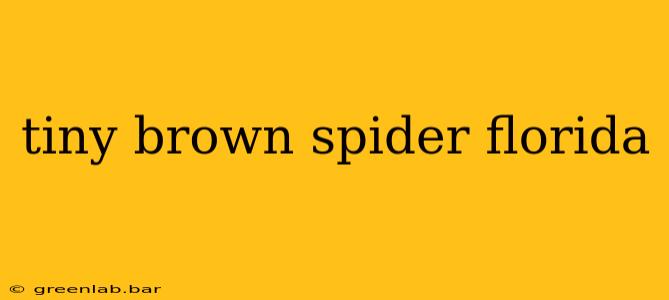Florida's warm climate provides a haven for a diverse array of spiders, many of which are small and brown. Identifying these tiny arachnids can be challenging, but understanding their common characteristics and potential dangers is crucial for homeowners. This guide explores common tiny brown spiders found in Florida, differentiating harmless species from those requiring caution.
Common Tiny Brown Spiders in Florida
Several spider species fit the description of "tiny brown spider" in Florida. Many are completely harmless, playing a beneficial role in pest control. However, some warrant extra attention. Let's explore a few:
1. Jumping Spiders (Family Salticidae)
Jumping spiders are prevalent throughout Florida. While many are larger and more vibrantly colored, several species are small and brown. They're easily identified by their:
- Excellent eyesight and hunting behavior: They stalk their prey, often jumping considerable distances.
- Robust bodies and hairy legs: They tend to have a thicker build than other small spiders.
- Varied coloration: Though often brown, they can display markings of other colors.
Jumping spiders are generally harmless to humans. They rarely bite, and their venom is not considered medically significant.
2. Cobweb Spiders (Family Theridiidae)
This family encompasses many small, brown spiders. Some species build messy, irregular webs, while others are more organized. Characteristics to look for include:
- Irregular web structure: Their webs aren't the classic spiral orb webs.
- Small, round bodies: They are often quite small, making identification difficult.
- Potential for mild venom: While generally not dangerous, some cobweb spiders possess venom that can cause localized pain.
Most cobweb spiders in Florida pose minimal threat, but it’s best to avoid handling them.
3. Other Small, Brown Spiders
Numerous other spider families include species that could be described as tiny and brown. Accurate identification often requires close examination under magnification or consultation with an arachnologist. These spiders usually play a crucial role in controlling insect populations within your home and garden.
Distinguishing Harmless from Potentially Harmful Spiders
While most tiny brown spiders in Florida are harmless, it’s important to know the differences:
- Aggression: Harmless spiders tend to avoid human contact, while more aggressive species might bite more readily.
- Web Type: The structure of the web can offer clues to the spider's identity.
- Physical Characteristics: Pay close attention to body shape, leg length, and any distinctive markings.
If bitten by a spider, monitor the area for any signs of infection or severe reaction. Seek medical attention if you experience symptoms such as severe pain, swelling, difficulty breathing, or nausea.
What to Do if You Find a Tiny Brown Spider
Unless you suspect a dangerous species, the best approach is often to leave the spider alone. Most spiders are beneficial, controlling pest insects. If the spider is in an inconvenient location, gently relocate it outdoors using a jar and a piece of cardboard.
Avoid using harsh pesticides, as these can harm beneficial insects and potentially contaminate your environment.
Conclusion
Encountering a tiny brown spider in Florida is a common occurrence. While some species are harmless and even beneficial, others require caution. By understanding the characteristics of common spiders and knowing when to seek professional help, you can coexist peacefully with these eight-legged residents. Remember, accurate identification is often best left to experts, and it's always better to err on the side of caution when handling any unknown spider.

